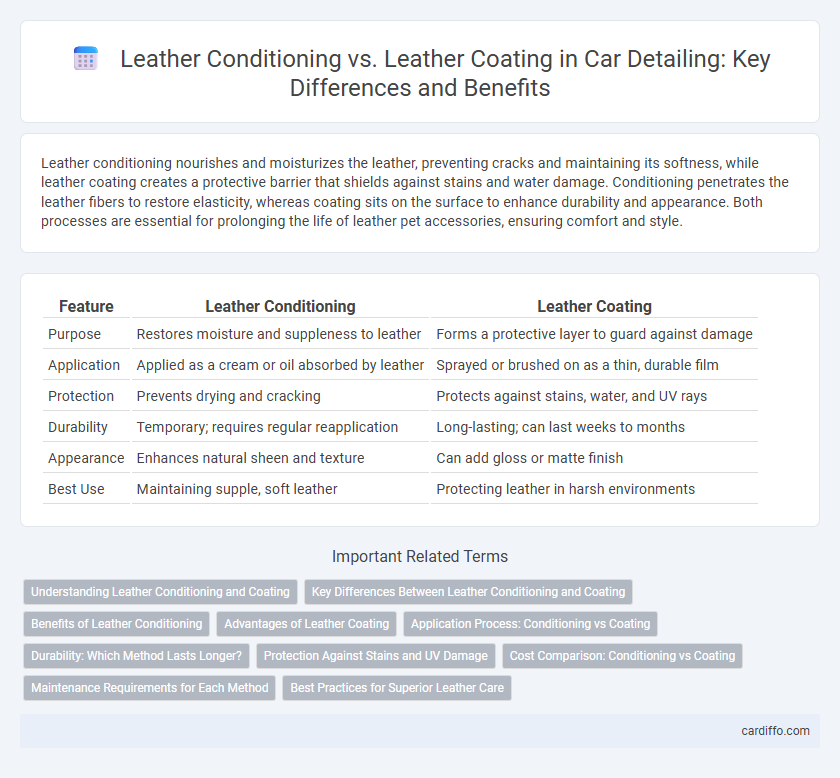Leather conditioning nourishes and moisturizes the leather, preventing cracks and maintaining its softness, while leather coating creates a protective barrier that shields against stains and water damage. Conditioning penetrates the leather fibers to restore elasticity, whereas coating sits on the surface to enhance durability and appearance. Both processes are essential for prolonging the life of leather pet accessories, ensuring comfort and style.
Table of Comparison
| Feature | Leather Conditioning | Leather Coating |
|---|---|---|
| Purpose | Restores moisture and suppleness to leather | Forms a protective layer to guard against damage |
| Application | Applied as a cream or oil absorbed by leather | Sprayed or brushed on as a thin, durable film |
| Protection | Prevents drying and cracking | Protects against stains, water, and UV rays |
| Durability | Temporary; requires regular reapplication | Long-lasting; can last weeks to months |
| Appearance | Enhances natural sheen and texture | Can add gloss or matte finish |
| Best Use | Maintaining supple, soft leather | Protecting leather in harsh environments |
Understanding Leather Conditioning and Coating
Leather conditioning involves applying specialized oils and moisturizers to restore flexibility, prevent cracking, and maintain the natural texture of leather surfaces. Leather coating refers to the application of protective finishes or sealants that create a durable barrier against water, stains, and UV damage, enhancing the longevity of leather products. Understanding the distinction between conditioning and coating is essential for effective leather care, as conditioning nourishes while coating shields the leather.
Key Differences Between Leather Conditioning and Coating
Leather conditioning involves applying moisturizers and oils to maintain leather's softness, flexibility, and prevent cracking, focusing on internal nourishment. Leather coating, on the other hand, adds a protective layer on the surface, enhancing resistance to stains, water, and wear without deeply hydrating the material. Key differences lie in conditioning's role in leather health and longevity, versus coating's function in surface protection and appearance preservation.
Benefits of Leather Conditioning
Leather conditioning restores natural oils, preventing cracks and maintaining suppleness for prolonged durability. It enhances comfort by keeping leather soft and breathable, reducing stiffness and wear over time. Regular conditioning also repels dirt and moisture, preserving leather's aesthetic appeal and extending its lifespan.
Advantages of Leather Coating
Leather coating creates a protective barrier that enhances durability and resistance to stains, UV rays, and moisture, extending the lifespan of leather surfaces. It maintains the leather's appearance by preventing fading and cracking, reducing the need for frequent maintenance compared to conditioning. This coating also offers easier cleaning and preserves the leather's texture, making it ideal for high-traffic or frequently used items.
Application Process: Conditioning vs Coating
Leather conditioning involves applying a specialized formula that penetrates the leather fibers to restore moisture, flexibility, and prevent cracking, typically using a soft cloth or applicator pad in circular motions. Leather coating, on the other hand, creates a protective surface layer by evenly spraying or brushing a durable sealant that shields against dirt, stains, and UV damage without altering the leather's natural texture. Conditioning requires absorption time for optimal effect, whereas coating cures on the surface, providing immediate protection and enhanced longevity.
Durability: Which Method Lasts Longer?
Leather conditioning penetrates the leather fibers, maintaining flexibility and preventing cracking, which extends the material's lifespan significantly. Leather coating, by creating a protective surface layer, offers immediate resistance to stains and scratches but may wear off faster under frequent use. For long-term durability, leather conditioning generally provides more lasting protection by nourishing the leather, while coatings require regular reapplication to maintain effectiveness.
Protection Against Stains and UV Damage
Leather conditioning penetrates the material to nourish and maintain its natural oils, enhancing flexibility and preventing cracking while offering moderate protection against stains and UV damage. Leather coating applies a protective layer on the surface, creating a barrier that effectively repels spills, stains, and harmful ultraviolet rays, thereby extending the leather's lifespan. Combining both methods ensures comprehensive defense, with conditioning preserving internal integrity and coating providing durable external protection.
Cost Comparison: Conditioning vs Coating
Leather conditioning typically costs between $50 and $150 per treatment, focusing on preserving suppleness and preventing cracks by infusing oils and moisturizers. Leather coating, often priced higher at $100 to $300, provides a protective barrier that enhances durability and resistance to stains or scratches through polymer-based finishes. Choosing between conditioning and coating depends on budget considerations and desired longevity, with conditioning offering maintenance benefits at a lower cost and coating delivering extended protection for a higher investment.
Maintenance Requirements for Each Method
Leather conditioning requires regular application of moisturizing products to maintain suppleness and prevent cracking, typically every 3 to 6 months depending on usage and environmental exposure. Leather coating involves applying a protective layer, such as a polymer or ceramic coating, which creates a durable barrier against dirt and stains, reducing the frequency of maintenance to once or twice a year. Proper maintenance of conditioned leather focuses on hydration and flexibility, while coated leather emphasizes cleaning and safeguarding the integrity of the protective film.
Best Practices for Superior Leather Care
Leather conditioning penetrates the material to nourish and restore suppleness, preventing cracks and dryness, while leather coating forms a protective barrier against stains, UV damage, and wear. For superior leather care, apply a high-quality conditioner monthly to maintain flexibility, followed by a durable coating every few months to shield the surface. Optimal results stem from using pH-balanced products specifically designed for the leather type, ensuring longevity and preserving the original texture.
Leather Conditioning vs Leather Coating Infographic

 cardiffo.com
cardiffo.com